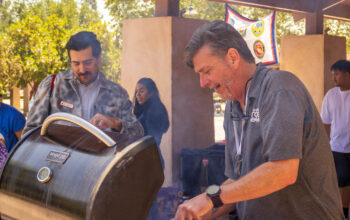A classic tale was transformed into a 1940s live radio show through “It’s a Wonderful Life: A Live Radio Play,” exploring the drama through the lens of actors who play multiple characters in a studio.
The cast and crew were impressive, an obvious amount of effort and practice going into the creation of the show. Details from the quintessential “applaud” sign to the small interactions between characters when they weren’t speaking to their listeners really made the production ooze the feel of a 1940s radio station.
“It’s a Wonderful Life: A Live Radio Play” will be playing over the weekends and Fridays until Dec. 15 in Pierce College’s temporary Performing Arts Complex. The classic tale was transformed into a live radio play by Joe Landry, and has been performed around the United States for nearly two decades.
The story was barely touched from the original, many of the lines still in place. The story still plays as it would – following the life and troubles of George Bailey (played by Vince Cusimano), and the town of Bedford Falls.
Director Frank Catalano made an interesting addition to the show, putting in a singing trio called “The Clarinda Sisters.” The group is reminiscent of the Andrew Sisters, who sung on radio and film and were popular in the 1940s.
The three sisters (Micaella Landers, Kristine Jhing Sillona, and Julianna Sillona-de Leon) added a lot to the ambiance of the set by singing commercials to the tune of Christmas songs during breaks.
The acting throughout was impressive, the six actors (Cusimano, Shannon Mary Dixon, Michelle Hallbauer, Mark Hein, Amir Khalighi, Michele Selin and Matti Lenora Werber) performing a wide range of voices to cover over twenty personalities all together.
Alongside their vocal talents, the cast had great interchanges between the characters they played on the set – murmuring to each other as other character played their parts, and jumping when the foley artist (played by Hallbauer) made particularly loud noises.
Hein was particularly expressive and entertaining throughout, at one peak of the play he ended up switching back and forth between voices as two characters he portrayed argued with each other.
The set was particularly detailed, including everything from a neon signs to indicate when to applaud or when the show is on air, a collection of equipment for the foley artist to use in sound effects, and the stereotypical microphones used in radio.
Minor details really allowed the set to further put forward the atmosphere of a radio station in the 1940s, making the characters, dress, and mannerisms really fall perfectly into place.
The combination of attention to details, fantastic acting and hard work truly showed in the performance, bringing the radio station to life and drawing the crowd in with ease, making it a wonderful play to see for the holiday season.



